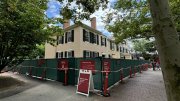To buttress its $500-million capital campaignand to foster the ethos of more complete disclosure by corporations and other institutionsHarvard Business School (HBS) has published an annual financial report. The document sets a precedent for Harvard's academic units and reveals in detail what had long been assumed: that HBS is attuned to the wider marketplace to a degree unique among the University's schools. Thus, it flourished during the robust economy that gathered momentum in the late 1990s, and has since had to adjust its expectations considerably. In that sense, HBS is a useful case study of the financial pressures facing Harvard overall.
For the fiscal year ended June 30, 2002, HBS received revenues of $286 million. Those funds came principally from its publishing operation ($92 million); executive education ($64 million); tuition and fees charged for the M.B.A. program, the core educational enterprise ($58 million); and distributions from the school's $1.34-billion endowment ($50 million). Compared to other schools, the external operationspublishing and executive educationloom unusually large. Moreover, HBS funds its professors' research through those vehicles, rather than by sponsored research (which underpins the medical and scientific faculties' work).
But that funding structure can be less stable than tuition and research grants. In fact, the report reveals, HBS rode a great wave from the fiscal years 1998 through 2001, as revenues swelled 30 percent (from $215 million to $280 million), and expenses climbed even more sharply, up 38 percent (from $195 million to $270 million). Robust growth in publishing and executive-education sales (along with the University-wide increase in endowment payouts) propelled 39 percent growth in nonfaculty staff positions during those yearsled by technology spendingand a quarter-million-square-foot expansion of campus facilities (21 percent).
The salad days ended abruptly during fiscal year 2002, as recession, September 11, and travel restrictions reduced executive-education enrollment and revenue sharply, and publishing sales softened; together, the two operations yielded $18 million less than anticipated for the year. In response, HBS administrators pared the expense budget by $20 million, principally by reducing staff in the economically sensitive operations.
Results for fiscal year 2003 will be published later this autumn. According to Donella M. Rapier, the school's associate dean for external relations and chief financial officer, publishing and executive-education revenues grew "only slightly," trailing expectations. Total revenues for current operations improved just modestly, and so expenses are being restrained through level staffing, stretching out maintenance, and deferring one-time technology investments and other discretionary projects. (Although the capital campaign forged ahead, yielding gifts and pledges of $360 million by June 30, most of those funds are for endowment or long-term use.)
Yearly fluctuations and economic conditions aside, HBSlike other Harvard schoolsfaces rising costs from continued growth in its faculty ranks, further spending on research and technology, and the renovation and expansion of its buildings. Given essentially level endowment distributions, it will likely rely on higher tuition fees and the success of its fundraisingplus reserves accumulated during the earlier flush years, and debt financing for capital projectsto sustain its near-term academic objectives. In these respects, HBS's recent roller-coaster experience anticipates the financial realities and expense disciplines now radiating throughout Harvard.





